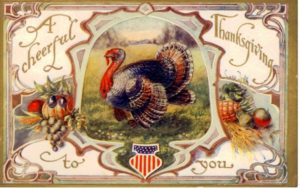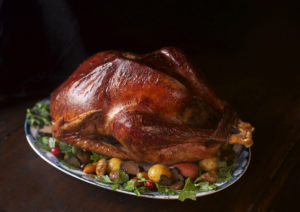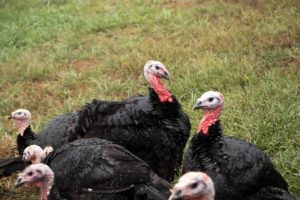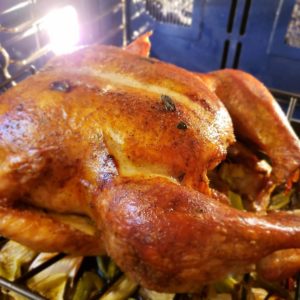
Thanksgiving is not far away, so I’m on the hunt: the hunt for the perfect turkey, that is.
The turkey I’m hunting for this year is a smaller bird; smaller than usual to better accommodate the fewer seats that will be set substantially apart around my table. The turkey I’m searching for is a bird with a pedigree: a heritage turkey.
Heritage turkeys are those majestic, gorgeous-looking birds featured in vintage Thanksgiving postcards, with breeds such as the Narragansett, Bourbon Red and Heritage Black. Smaller than the genetically modified white turkeys that dominate today’s market, heritage turkeys provide more than an interesting culinary story. They have a rich flavor like no other bird on the market, and that’s the reason they’re trending among carnivores craving a taste from the past.
To capture a heritage turkey for the holiday table, one needs to know where to hunt, or make that shop. Begin with checking local meat companies, such as Kern Meat Co. Or browse online for specialty gourmet purveyors, like dartagnan.com, who were among the first to introduce heritage turkeys to the market.

“We were on the forefront,” said Ariane Daguin, CEO of D’Artagnan, which offers two heritage breeds: the Narragansett and the Bourbon Red, along with a limited supply of wild turkeys.
“These birds, which are produced for us, are free range and were originally bred from the wild turkey. They have become very popular. People are flocking to them because of their smaller size and taste, which is a trend we think will continue,” Daguin said.
D’Artagnan’s wild turkeys are similar except they are a thinner bird that produces a darker meat and earthy flavor gourmets and gourmands can appreciate. Earthy flavors do complement turkey nicely, which may have been the inspiration for D’Artagnan’s newest turkey option, Truffle Turkey Breast, a delicate moist turkey breast blanketed with black truffles, which is ready to heat and serve. It makes a delightful gourmet addition to the Thanksgiving or holiday table.
While talking turkey, Daguin noted when it comes to heritage turkeys, it’s all about the genetics, a fact of which Matt Sherman, general manager at Kern Meat agrees.
“Genetics matter. We have bred the flavor out of everything in our quest for efficiency,” Sherman said. “If you want to have more flavor, you have to pay attention to genetics.”
Kern offers the Black Heritage turkey, a breed recognized by the American Poultry Association since 1874, and is the breed believed to have been eaten by the pilgrims.

“The Black Heritage looks like a wild turkey hen – black feathered and a little thinner,” Sherman said. “What makes them nice is they have a thinner skin, so they crisp up a lot better, and they have a little bigger breast than a wild turkey. Because these birds have a little more fat than the regular commercially produced turkey, they have more flavor.”
Sherman’s recommended recipe for a Black Heritage turkey is simple: Stuff the cavity of the bird with apples and onions, rub it down with a little salt, brush with a combination of olive oil and butter with a little sage and roast. That’s it. Keep it easy, and as Sherman said, “Let the turkey express the flavor naturally.”
Heritage birds do cost more than the grocery loss leader birds. However, it’s worth it considering their succulent flavor and their lineage, especially for foodies, history buffs and anyone who wants to party like a pilgrim.

Roast Heritage Turkey with Bourbon and Pecan Stuffing
Courtesy of D’Artagnan
1/2 tablespoon olive oil and oil to brush on aluminum foil
1 cup sweet Italian sausage meat, removed from casing and crumbled
1 small onion, finely chopped
1 stalk celery, finely chopped
1 1/2 teaspoons chopped fresh rosemary leaves or 1/2 teaspoon dried rosemary, crumbled
1 1/2 teaspoons chopped fresh thyme leaves or 1/2 teaspoon dried thyme leave
3/4 cup bourbon
1/4 cup pecan halves, coarsely chopped
1 egg, beaten
6 slices stale Italian bread, crumbled, about 6 cups
4 1/2 to 5 1/2 cups turkey or chicken stock
Salt and freshly ground black pepper, to taste
1 heritage turkey (8 to 10 pounds)
2 tablespoons all-purpose flour
Preheat oven to 450 F. Brush a piece of aluminum foil with oil and place it on a rack in a roasting pan. Heat oil in a large heavy skillet over medium-high heat. Add sausage and cook until browned and no pink remains, 5 to 6 minutes, stirring and breaking it up as it cooks. Pour off all but 2 tablespoons of fat. Add onion, celery, rosemary and thyme, and cook until onion is soft. Add 1/4 cup of bourbon and bring to a boil. Remove from heat and let cool.
Combine sausage mixture with pecans and egg. Add bread, 1/2 cup of the stock, salt and pepper, and gently toss to blend. Stuffing should be a little dry. Set aside to cool. Stuff turkey loosely with stuffing, truss and set it, breast-side down, on rack in roasting pan. Add 2 to 3 cups of the stock, 1/4 cup of bourbon, and cook for 10 minutes. Adjust heat down to 325 F., and roast for 20 minutes more, basting every 10 minutes. Turn turkey on one side and roast 30 minutes. Turn to other side and roast 30 minutes more. Turn turkey breast side up and roast 15 minutes longer. Continue to baste every 10 minutes. Turkey is done when meat is soft to the touch, leg moves easily in the joint, and an instant-read thermometer measures 180 to 185 F when inserted into deepest part of thigh. Remove turkey from pan and set aside, breast side down.
Pour pan juices into a bowl or fat separator, and skim off as much fat as possible. Reserve about 2 tablespoons of fat. On top of stove, add enough of the remaining stock to pan juices to make 1 1/2 cups liquid. Add fat to roasting pan and sprinkle on flour. Stir over medium heat until flour begins to brown. Whisk in pan juices and remaining 1/4 cup of bourbon, and bring to a boil for 5 minutes. Season with salt and pepper, to taste.

Perfect Black Heritage Turkey
Courtesy of Joyce Farms
Brine
1 cup Kosher salt
1 ounce fresh ginger
1/2 cup light-brown sugar
1 head garlic
1/2 unchanged parsley stems (reserve leaves for the herb butter)
2 tablespoons whole black peppercorns
1 gallon chicken vegetable stock
3 bay leaves
10 pounds ice cubes
Heat the cooking stock in a large stock pot, but do not boil. Add the salt and sugar, stirring to dissolve. Roughly chop the ginger and add to pot. Slice open the head of garlic and add. Add the peppercorns, bay leaves and parsley stems. Remove from heat and allow to cool to room temperature. Add the ice cubes to the brine liquid, stirring to fully chill.
Turkey
1 14- to 16-pound Heritage Black Turkey
2 league springs fresh thyme
1 1/2 sticks butter
1 lemon
1/4 cup parsley leaves
1 medium white or yellow onion
1 orange
1/2 teaspoon Kosher salt
1/2 cup dry white wine
1/2 teaspoon freshly ground black pepper
1/4 cup fresh sage leaves
1 clove garlic. peeled
Kosher salt and black paper as needed
Once the brine is cold, remove the fresh (or defrosted) Heritage Black Turkey from its packaging. Remove the neck and liver from the cavity, reserving for later use. Submerge the turkey, breast side down, in the brine, and allow to soak for 24 hours, turning once. Note: It is suggested to use an oven bag or brining bag to brine the turkey with less mess. If your refrigerator is not large enough to hold the brining turkey, you can put the turkey in its brining bag into a cooler, as long as you pack with plenty of ice to keep the temperature of the turkey under 38 F while brining, for food safety.
To make herb butter, first soften the unsalted butter to room temperature. Add the parsley leaves, thyme leaves, sage leaves and peeled garlic clove to a food processor. Process to a paste. Add the zest of the lemon (set the zested lemon aside to use later) and season with salt and pepper. Add the softened butter and process until the butter is whipped and the mixture is fully blended. With the food processor running, slowly, add the white wine.
Remove the turkey from the brine mixture and pat dry with paper towels. Gently slide your fingers in-between the meat and the skin over the breast. Approach from the neck, as well as the body cavity to create a pocket. Insert as much of the herb butter as possible over each breast lobe. Use your fingers to spread the herb butter evenly over the breast meat. Peel and cut the onion in half. Cut the orange and the zested lemon in half. Insert the cut fruit and the onion into the body cavity of the turkey. Insert the remaining sprigs of thyme into the body cavity.
Truss or tie with string the legs of the turkey to ensure even cooking. Fold the wings under the bird and place it on a roasting rack on a rimmed roasting pan (if you are making a gravy, add the neck and liver to the pan to flavor the pan juices), and insert into a pre-heated 325 F oven. Allow to cook for two hours, then check the internal temperature by inserting a calibrated probe thermometer into the thickest part of the thigh. Continue to cook until the internal temperature has reached 165 F. If the skin over the breast begins to get too dark, loosely cover with aluminum foil while the dark meat continues to cook. Once cooked, allow to rest for at least 20 minutes before carving.





